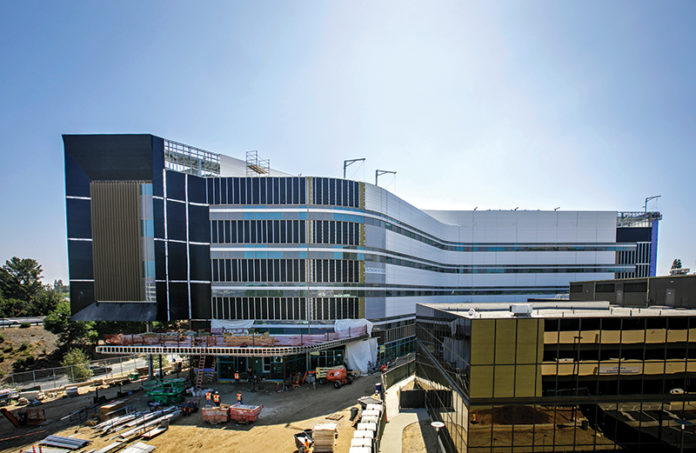Hospitals around the state face spending so much money to meet a 2030 deadline to seismically upgrade their facilities that they are trying to convince lawmakers to postpone and narrow the scope of the deadline.
But hospitals in the San Fernando and Santa Clarita valleys find themselves in better shape than many of their counterparts in L.A. County – ironically because of the damage suffered during the 1994 Northridge earthquake.
That damage led many hospitals in the valleys to replace key buildings over the past 20 years, ahead of both the 2030 deadline and a previous 2020 cutoff date to ensure buildings are structurally sound.
“There was a tremendous amount of hospital construction in the Valley in the early 2000s,” said Ola Ostlund, co-founder of Monrovia-based Hallsta Inc., a hospital consulting firm.
As a result, Ostlund said, these facilities collectively have less work to do to meet the 2030 deadline than hospitals in the rest of Los Angeles County.
“A lot of buildings that have work remaining are support buildings with limited direct patient services but still must be retrofitted to ensure the hospital campuses can keep functioning after a quake,” Ostlund said. “But the work will likely be less than those campuses that haven’t replaced any buildings.”
Among the hospitals that replaced major patient buildings were Valley Presbyterian Hospital in Van Nuys, Providence Holy Cross Medical Center in Mission Hills and Providence St. Joseph Medical Center in Burbank, as well as West Hills Hospital and Medical Center.
State deadlines
Most of these hospital replacement buildings were constructed to meet an earlier state deadline to ensure all acute-care hospital structures would remain standing after a major quake. That law was passed in 1983 after two hospitals in Sylmar – the San Fernando Veterans’ Administration Hospital and Olive View Community Hospital – suffered total or partial collapses during the 1971 San Fernando quake, killing 52 people. This deadline was originally set for 2008 but was ultimately pushed back to 2020 after hospitals repeatedly contended they did not have the financial resources to upgrade or replace facilities in time.
After the 1994 Northridge quake, which resulted in eight hospitals having to evacuate patients, a second mandate was passed, one requiring that by Jan. 1, 2030, all acute-care facilities must be deemed capable of remaining fully operational following a major quake.
According to figures from the California Hospital Association, a Sacramento trade and advocacy group, 14 (or 74%) of the 19 hospital campuses in the San Fernando, Santa Clarita and Antelope valleys still have at least some work to do to meet the 2030 deadline. That’s just a slightly smaller percentage than the 78% of the 93 hospital campuses countywide that have yet to meet the cutoff date.
A 2016 study from Santa Monica-based Rand Corp. projected a huge cost range to bring hospital campuses countywide into compliance with the 2030 mandate. On the low end, the cost was pegged at $8.7 billion, assuming all the acute-care buildings need retrofits only. The high-end cost was projected at $39.5 billion, assuming all acute-care buildings needed to be replaced.
All this work looms as hospitals face financial troubles. Prior to the pandemic, many facilities that were not well-capitalized or that served large populations of uninsured patients were operating in the red, according to Kiyomi Burchill, group vice president of policy for the California Hospital Association.
Burchill said the Covid-19 pandemic only worsened the financial situation. She cited data collected by consulting firm Kaufman Hall & Associates on behalf of the association that showed for 2021, 53 of the county’s 93 hospital campuses were operating in the red.
Citing these and other statewide figures, the CHA is pushing for legislation to postpone and narrow the scope of the mandate.
Under the CHA proposal, hospital buildings with emergency rooms and trauma centers would have the deadline pushed back to 2037, while all other acute care facilities – primarily hospital inpatient services – would no longer have to meet the requirement that they remain fully operational after a quake. Spokeswoman Jan Emerson-Shea said almost all of these non-emergency inpatient facilities now meet structural integrity standards designed to save the lives of patients.
Tarzana hospital work
Regardless of whether the CHA proposal passes, work continues at local hospitals.
One of the last of the major hospital building replacement projects in the Valley is wrapping up within the next 12 months: a $624 million modernization project that includes a new patient tower at Tarzana Medical Center, which is jointly owned by Renton, Wash.-based Providence and Beverly Grove-based Cedars-Sinai Health System.
Only one more major project similar in scope to the Tarzana Medical Center has been publicly announced: a replacement 350-bed patient building for Antelope Valley Medical Center in Lancaster that could cost as much as $800 million. It took several years for hospital executives there to line up funding; groundbreaking for three years of construction is expected sometime later this year.
